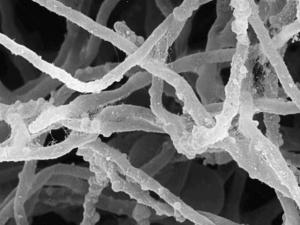Phanerochaete chrysosporium: Difference between revisions
| Line 37: | Line 37: | ||
Phanerochaete chrysosporium is a crust fungi, which forms flat fused reproductive fruiting bodies instead of the mushroom structure. This fungi exhibit an interesting pattern of septate hyphae, giving a stronger line of defense in times of distress. The hyphae network has some branching, with diameters ranging from 3-9 µm. At the ends of the hyphae rests chlamydospores, thick-walled spores varying from 50-60 µm. The conidiophore gives rise to round asexual blastoconidia, which are 6-9 µm in diameter. [1,2] | Phanerochaete chrysosporium is a crust fungi, which forms flat fused reproductive fruiting bodies instead of the mushroom structure. This fungi exhibit an interesting pattern of septate hyphae, giving a stronger line of defense in times of distress. The hyphae network has some branching, with diameters ranging from 3-9 µm. At the ends of the hyphae rests chlamydospores, thick-walled spores varying from 50-60 µm. The conidiophore gives rise to round asexual blastoconidia, which are 6-9 µm in diameter. [1,2] | ||
Describe any interesting features and/or cell structures; how it gains energy; what important molecules it produces. | |||
==Ecology== | ==Ecology== | ||
Revision as of 06:08, 8 March 2008
A Microbial Biorealm page on the genus Phanerochaete chrysosporium
Classification
Higher order taxa
Eukaryota; Fungi/Metazoa group; Fungi; Dikarya; Basidiomycota; Agaricomycotina; Agaricomycetes; Agaricomycetes incertae sedis; Corticiales; Corticiaceae; Phanerochaete
Species
|
NCBI: Taxonomy |
Phanerochaete chrysosporium
Description and significance
Phanerochaete chrysosporium is called a white rot fungus for its specialized ability to degrade lignin, while leaving the white cellulose available for degradation by other organisms. Phanerochaete chrysosporium releases extracellular enzymes to break-up the complex three-dimensional structure of lignin into components that can be utilized by its metabolism. The extracellular enzymes are non-specific oxidizing agents (hydrogen peroxide, hydroxyl radicals) used to cleave the lignin bonds. [3]
Describe the appearance, habitat, etc. of the organism, and why it is important enough to have its genome sequenced. Describe how and where it was isolated.
Include a picture or two (with sources) if you can find them.
Genome structure
Phanerochaete chrysosporium is the first member of the Basidiomycetes to have its complete genome sequence. The genome consists of 30-million base pairs Describe the size and content of the genome. How many chromosomes? Circular or linear? Other interesting features? What is known about its sequence? Does it have any plasmids? Are they important to the organism's lifestyle?
Cell structure and metabolism
Phanerochaete chrysosporium is a crust fungi, which forms flat fused reproductive fruiting bodies instead of the mushroom structure. This fungi exhibit an interesting pattern of septate hyphae, giving a stronger line of defense in times of distress. The hyphae network has some branching, with diameters ranging from 3-9 µm. At the ends of the hyphae rests chlamydospores, thick-walled spores varying from 50-60 µm. The conidiophore gives rise to round asexual blastoconidia, which are 6-9 µm in diameter. [1,2]
Describe any interesting features and/or cell structures; how it gains energy; what important molecules it produces.
Ecology
Due to Phanerochaete chrysosporium sustainability at moderate to higher temperatures, specifically 40 degrees celcius, this white-rot fungus can be found in forests ranging from North America, to areas of Europe and in Iran. [4] A main role it assumes is that of degradation of the complex lignin from various trees and plants. This process reduces lignin into less complex molecules, maintaining the cycle of the decomposer of plants.
Recent studies have revealed an association of a certain bacteria found in conjunction with this strain of fungi. Agrobacterium radiobacter was isolated as coexisting with the fugi, and very difficult to separate. [5] Discovery of how bacteria and fungi affect each other physiologically is yet to be conclusive, but further research could give further evidence of mutualism, and its affect on bioremdiation.
Pathology
How does this organism cause disease? Human, animal, plant hosts? Virulence factors, as well as patient symptoms.
Application to Biotechnology
Does this organism produce any useful compounds or enzymes? What are they and how are they used?
Current Research
Enter summaries of the most recent research here--at least three required
References
1. Burdsall, H. (1985) Mycologia Memoir 10, 61-63. 2. Nakasone, K. (1990) Mycologia Memoir 15, 224-225. 3. Burdsall, H. (1974) Mycotaxon 1, 124. 4. Burdsall, H. (1985) Mycologia Memoir 10, 61-63 5. F. Seigle-Murandi, P. Guiraud, J. Croize, E. Falsen, and K. L. Eriksson, "Bacteria Are Omnipresent on Phanerochaete chrysosporium Burdsall." "Applied and Environmental Microbiology Journal." 1996 July; 62(7): p.2477–2481. [Sample reference] Takai, K., Sugai, A., Itoh, T., and Horikoshi, K. "Palaeococcus ferrophilus gen. nov., sp. nov., a barophilic, hyperthermophilic archaeon from a deep-sea hydrothermal vent chimney". International Journal of Systematic and Evolutionary Microbiology. 2000. Volume 50. p. 489-500.
Edited by student of Kate Scow

